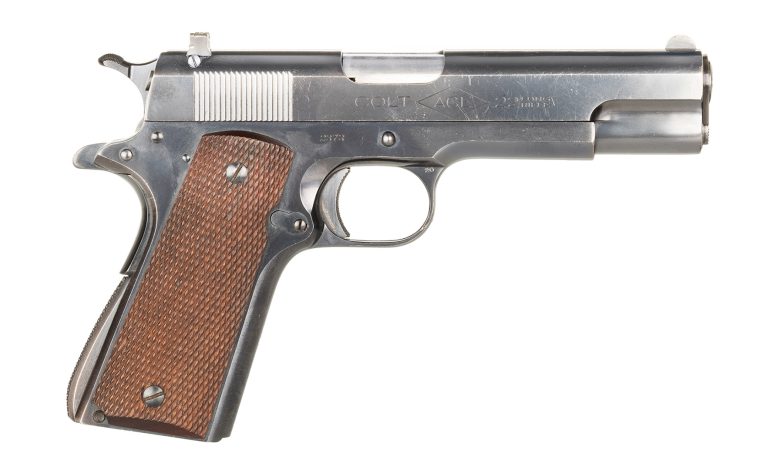The Classics: The Colt Ace

If you are a collector of fine American firearms, you may have already concluded that the 1930s were the “golden age” of pistols and revolvers. Across the board, the popular manufacturers—Smith & Wesson, Colt, Savage, Winchester and Remington—all produced a product that, in its workmanship and beauty, has rarely been surpassed since. The mirror-blue finish on a Colt New Service and the brilliant red stain on a Winchester ’94 are truly works of art. There is a reason why some collectors prefer “pre-64” manufactured guns, although for me it has always been pre-World War II guns. The attention to detail, hand finishing and pure perfection all were lost when the engines of war demanded millions of numerous models to be made in record time. Shortcuts meant efficiency, economy and increased profits, but pride in workmanship suffered.
But, fret not dear reader; hopefully this tome will transport us back to a time when life was simpler, art deco ruled architecture and big bands were serenading our forebears on the factory floors of New England.
This particular story begins back in 1911, when John M. Browning’s classic .45 ACP semi-automatic pistol was adopted by the U.S. military, and Colt Patent Firearms Manufacturing Company of Hartford, CT, began to produce the most iconic American sidearm of the 20th century.
Back in the pre-World War I era, our military was strapped for funds, as were most nations at the time. Dollars for defense was not a popular platform in Congress, and all the branches of the military felt the monetary pinch. It wasn’t long, 1913 to be exact, before the Army asked the Springfield Armory to look into a pistol chambered in .22 LR that could be used for marksmanship training that would be better for the budget than supplying tens of thousands of .45 ACP rounds. In typical government fashion, it took more than a decade before a suitable example would be supplied for field tests.
The product came from none other than Colt itself, with a patent awarded in 1924. The resulting pistol was a .22-caliber rimfire that looked and felt just like the 1911. Field trials began shortly thereafter with all branches of the military, and after positive results supervised by COL Townsend Whelan of the Springfield Armory and MAJ Julian Hatcher of the U.S. Army Ordnance Department (both later Technical Editors of American Rifleman), the Colt Ace began manufacture in 1931.
The Ace was nearly identical to the 1911A1, even down to the full-checkered wooden grips, trigger guard cut out and arched mainspring housing. It found immediate acceptance within military circles, and more than 10,000 were produced over the next decade. The main desire for the military was to provide Soldiers, Sailors, Airmen and Marines with a handgun with which they could train that looked and felt like the standard M1911. The problem was the recoil from a .22 LR is not similar to that of a .45 ACP.
Enter one of the most controversial firearm designers of the 20th century, David Williams. By most accounts, “Carbine” Williams left something to be desired in the warm and fuzzy department. Expelled from school in the eighth grade, he joined the Navy at the age of 15 and was soon discharged for lying about his age. He was then expelled from a military academy for stealing, of all things, some firearms and ammunition. By 1921 he was operating his own still in his home state of North Carolina, and in August of that year he was charged with the murder of deputy sheriff Alfred Jackson Pate. He was convicted of the charges and sentenced to 30 years at hard labor.
Sights on the Ace were as minimalist as those on the .45 ACP 1911A1: a thin, half-moon blade up front and a skinny notch in a black rear sight • Precise engineering was needed to get the Ace to both feed properly and give a recoil impulse similar to the .45 ACP.
While in prison, working in the machine shop, he designed a number of firearm systems and improvements. He had his sentence commuted by the governor and was released in 1929. He soon found work at Colt, and turned his attention to overcoming the inherent problem the Ace had with replicating the feel and function of the 1911.
He obtained a patent for a floating chamber in 1937 that became the foundation for the Service Model Ace. The floating chamber was similar to a delayed-blowback system that allowed the pressure of the escaping gases to build up to the point that felt recoil was significantly greater than that of the standard .22 LR cartridge. This “floating chamber” mechanism gives the Ace a real sense of recoil, and thereby gives the practicing service member a closer experience to having fired a standard service sidearm—for pennies per shot.
Williams, who would later design the M1 carbine prior to World War II, was the main character in the 1951 film “Carbine Williams,” which gave him the nickname that he carried for the rest of his life.
Colt went on to produce and market 12,000 Service Model Ace pistols from 1936 to 1946. The company’s sales, to both the military and the civilian market, overlapped with the sales of the Ace model without the “floating chamber” enhancement. Sales of both models were suspended during World War II, though some guns were made up of pre-war parts and sold commercially for a few years following the war.
It didn’t take too long before the Ordnance Department came to the realization that they were buying two pistols from Colt that were interchangeable in half the parts used to produce them. In 1936, Colt began marketing and selling a conversion unit that allowed the purchaser to simply replace the slide and barrel assembly on a 1911 or 1911A1 frame and, voilà: You had a Service Model Ace for a fraction of the cost. Colt made a number of conversion units in various configurations and markings all the way up until the 1970s.
The field of collecting Colt Ace and Service Model Ace pistols and their various conversion units will keep any enthusiast busy for a lifetime. Limited to a total of 22,000 units produced, this is one of the finest firearms to come out of the pre-World War II era.
Read the full article here







